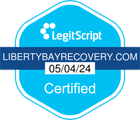In 1970, Congress passed the Controlled Substances Act. This legislation classifies and establishes clear regulations restricting access to drugs more likely to be abused. Because of its limited potential for addiction and abuse, Klonopin (clonazepam) is classified as a Schedule IV controlled substance. However, risks of addiction and other adverse outcomes increase with prolonged drug use. While it is important to remember that many medications prescribed by a doctor are safe and helpful to your health and welfare when used correctly, there are certainly those who abuse prescription medications.
What Makes Klonopin a Controlled Substance?
People with epilepsy or anxiety disorders are often prescribed the benzodiazepine Klonopin. The calming effect of Klonopin is achieved by decreasing activity in the nervous system, allowing the user to unwind and feel at ease. Unfortunately, it is this calming effect that makes Klonopin misuse common. Using this drug can cause a person to become physically dependent and addicted.
Like other Schedule IV medications, Klonopin is often prescribed for brief periods because most people develop a tolerance to the medicine within weeks. The danger of developing a physical dependence increases with both the dosage and its frequency of administration. Thousands of Americans die from overdoses involving benzodiazepine medicines like Klonopin every year. These fatalities are often the result of a combination of benzodiazepine and opiate drug misuse.
Controlled Substance Categories
Drugs are divided into five schedules, or categories, based on their potential for abuse and addiction:
- Schedule I: Have no legitimate medicinal use and a high potential for misuse (heroin, ecstasy).
- Schedule II: These are highly addictive and can be harmful to the user (Adderall, OxyContin).
- Schedule III: Have a moderate to low potential for abuse and a reduced risk of addiction and dependence (Tylenol 3).
- Schedule IV: Have minimal potential for abuse and a modest risk of addiction (Klonopin, Xanax).
- Schedule V: Have limited potential for abuse (cough medication with codeine).
Klonopin Prescription Monitoring Drug Programs (PMDP)
Currently, 49 states have implemented monitoring of prescription drug programs. By entering prescriptions into a central database, these programs make it more difficult for clients to “doctor shop” for medicines like Klonopin.
Unfortunately, the system is not perfect. Some drug firms offer incentives to doctors so they will prescribe more of certain medications. Nonetheless, the availability of Klonopin has been lowered thanks to prescription drug monitoring programs. In addition, PMDPs ensure tighter control over controlled substances to reduce the likelihood of Klonopin dependence.
Klonopin Dependence and Abuse
People who misuse benzodiazepines, including Klonopin, often switch to heroin because it is often easier to get than prescription medications. Unfortunately, street drugs are much more dangerous than prescription drugs because they are frequently mixed with harmful compounds, such as soaps, detergents, or powerful and dangerous narcotics.
Counterfeit prescription medication or “pressed pills” have become common throughout the United States. As a result, when Klonopin is bought off the street, there is no guarantee that the tablets will be what they are supposed to be. Pressed pills and many other street drugs may contain fentanyl, a synthetic opioid 100 times more potent than morphine and 50 times more powerful than heroin. According to the DEA, just 2 mg of fentanyl can be lethal, and there is no way of knowing if or how much of this deadly drug may be mixed into street drugs.
An all-encompassing treatment program may be the most effective choice for someone battling Klonopin usage and addiction. Many people start taking Klonopin because it makes them feel relaxed. Finding healthy, alternative methods of dealing with stress is a significant part of addiction therapy. The best drug rehabilitation centers provide a comprehensive treatment plan, including multiple effective therapies. Some clinics offer dual-diagnosis treatment for people struggling with addiction and mental health problems. Therapy, yoga, nutrition, and exercise are all possibilities.
Effects of Stopping the Use of Klonopin
Depending on the individual’s method of quitting, Klonopin withdrawal can manifest in several ways. First, you can try to stop without any gradual tapering. This technique translates to you taking your usual dose of Klonopin one morning and then nothing at all the next, and it’s also called quitting “cold turkey.”
This method of Klonopin withdrawal is unsafe and poses a life-threatening risk to some users. In most cases, this withdrawal method is chosen when users have no more medication and are prepared to stop but don’t want to or can’t go to a facility to help them through the process.
If you wish to stop using Klonopin, a gradual taper is the safest way. Professional guidance from medical professionals adds an extra layer of safety. Tapering reduces the amount of Klonopin in your system over time, lessening the severity of withdrawal symptoms and protecting you. It also allows your brain and body time to acclimate to functioning without the drug.
Reducing Klonopin Dosage: What to Expect
Your ability to tolerate the decreased Klonopin dosage will be assessed before beginning a taper. While various factors will determine your taper schedule, some doctors have successfully reduced the dosage by 0.5 milligrams weekly until the client reaches 1mg. After that point, the dosage is reduced by 0.25 mg per week. Of course, everyone has unique needs, and a medical professional will evaluate you fully before making any decisions.
Klonopin Withdrawal Symptoms
Sleeplessness, anxiety, and irritability are some early withdrawal symptoms. Withdrawal from Klonopin can start as late as 72 hours after the last dose but typically begins within 24 hours, depending on individual and metabolic factors.
You may experience Klonopin withdrawal symptoms, such as nausea, vomiting, muscle spasms, dizziness, sleeplessness, and more for up to a week. The severity of Klonopin withdrawal symptoms increases with time, reaching a peak at the end of the first week.
Initial Klonopin withdrawal is manageable, and symptoms are usually mild when you slowly wean off the drug. It’s possible that anxiety could return after tapering, but it would likely be manageable, and it will gradually subside, eventually going away by months two to three after withdrawal.
Emergence or Recurrence of Mental Health Conditions
People misusing Klonopin may not address their underlying mental health conditions. As a result, concealed symptoms can reappear during the Klonopin withdrawal process. These symptoms can include anxiety, panic attacks, depression, confusion, delirium, and more.
Sleep Deprivation
Klonopin is often used as a sleep aid, and those who opt to stop using the drug may experience problems sleeping. They may also have disturbing dreams and night sweats. Clients may find this frustrating because withdrawal is painful, and most prefer sleeping through the worst symptoms. However, many people who are tapering off Klonopin will not only experience insomnia, but they’ll also be hyper-alert.
Depression
While Klonopin is not commonly prescribed for depression, it may help with the anxiety that sometimes accompanies it. As such, depression, sadness, loss of interest, and lack of care may worsen once Klonopin is stopped. If you’re struggling with depression, consulting a mental health professional is the best way to get on an effective treatment plan.
Klonopin Dependence Treatment
Admitting that you have a problem with substance use disorder is the first step toward recovery. Next, you should seek advice about recovery from a professional. Although confiding in a peer may be comforting, regularly speaking with a healthcare professional will be more beneficial. Substance use disorder is difficult to overcome without medical supervision. For this reason, finding professional recovery treatment is vital. After you begin treatment, you can take the following steps to smooth up the rest of the path to recovery.
Admit Your Klonopin Dependency
It is important to tell your loved ones about your substance dependency. Friends and family can offer support to help you recover and beat your addiction. Admitting that you have been abusing or misusing Klonopin and have become dependent allows your loved ones to learn how they can contribute to your journey toward recovery.
Check Your Environment
A key contributor to addiction and successful recovery is the environment that you expose yourself to. When you can easily get Klonopin or other addictive drugs, the chance of developing substance use disorder is higher, and remaining in that environment makes successful recovery less likely. Another hindrance to recovery is loved ones struggling with substance misuse. Individuals with substance use disorders should check and assess their environment to ensure that it helps them recover.
Get Help at Liberty Bay Recovery
Addiction to drugs or alcohol is complex, and recovery can be a long, hard road. According to experts, it is estimated that one in 12 adults in the United States struggle with substance use disorder, yet those who experience it frequently feel isolated in their fight. At Liberty Bay, you can get the help and information you need to start everything afresh. Our team members all believe in the same core values. Professionalism, enthusiasm, and genuine concern guide our work. Some of our staff are ex-addicts too. This quality makes our team so good at connecting with and understanding clients.




